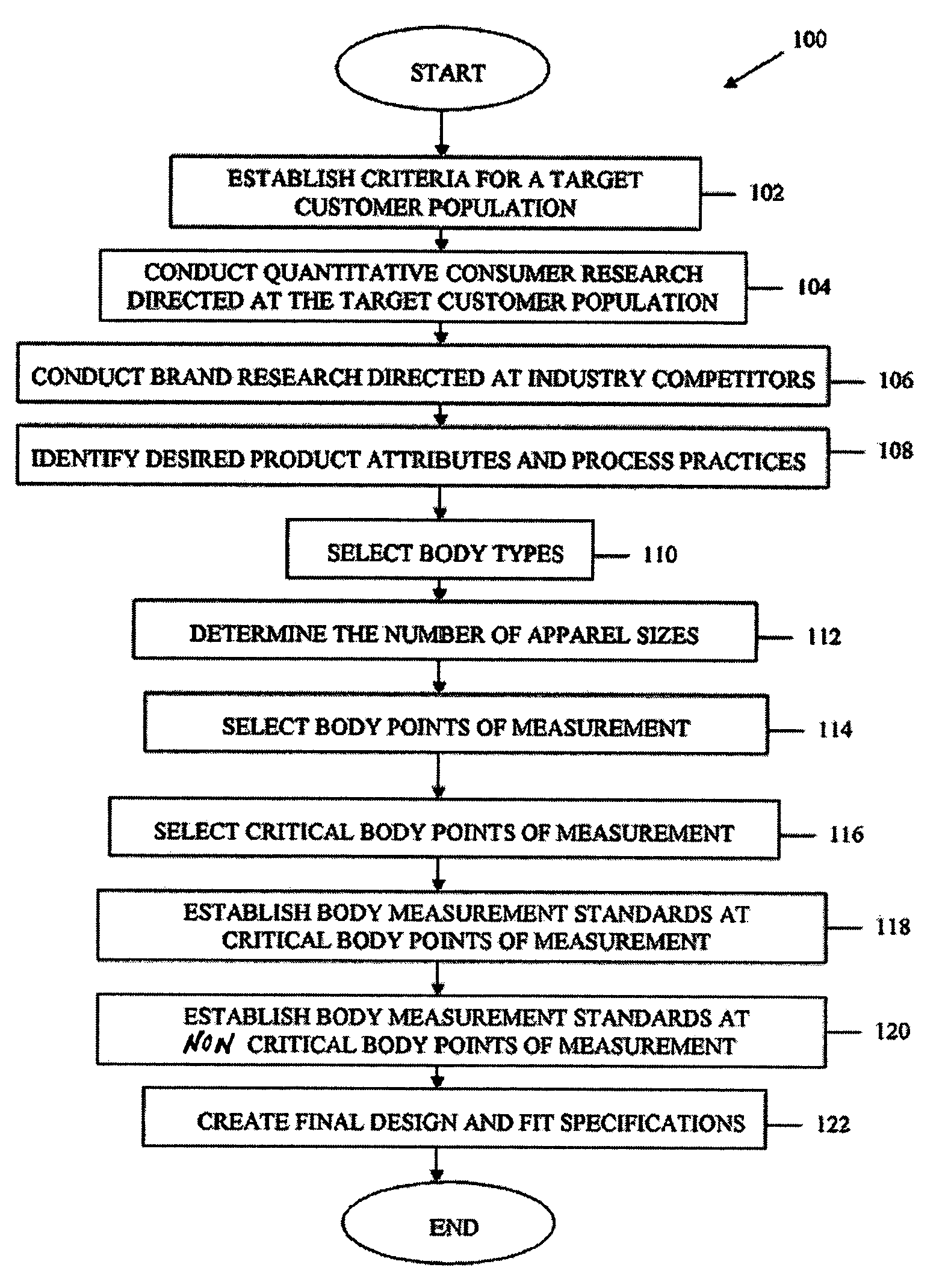Systems and methods for improved apparel fit
a technology of apparel and fit, applied in the field of apparel fit improvement systems and methods, can solve the problems of affecting the level of apparel spending and brand satisfaction, the cost of apparel companies and retailers is tangible as well as intangible, and the consumer's apparel fit problem continues to plague consumers, etc., to achieve a comprehensive and accurate method of fitting, increase retail inventories, and increase sales without increasing inventory quantities
- Summary
- Abstract
- Description
- Claims
- Application Information
AI Technical Summary
Benefits of technology
Problems solved by technology
Method used
Image
Examples
example a
[0056]For a selected consumer group (e.g., teen females, “Baby Boomer” women), identify a set of data for analysis and establish search criteria for the data, such as age. Query the data to establish new size groupings and any other indicators for that age. Queries may be based on qualitative or quantitative research (using focus groups, apparel-related databases, questionnaires etc.). Research is used to determine product attributes that include: fit and design. Fit product attributes includes fit, ease, sizing, etc. Design product attributes include “wearability” features, such as placement of zippers, pocket placement, sleeve lengths, fabrics, styles, colors, pricing, etc. Optionally, brand research may be conducted to identify successful apparel brands, product attributes, and designs sold to the target group.
[0057]New size groupings should lie within industry standard sizings. For example, women size groupings should be comparable to “Missing” industry sizes; teen female size g...
example b
[0064]Conduct survey of a target population to determine common body measurements, body types, and preferences via: market survey (for analysis of research data of potential consumers' needs to determine preferences and body types); competitive analysis (to analysis target consumers' preferences for best fit); database analysis (e.g., SizeUSA national sizing database, in which participants have had bodies scanned using three-dimensional body scanning and body measurement software and for which criteria will be established followed by analysis of scanned data).
[0065]Establish customized body measurement standards for each size (and body-type) in range, based upon above survey results. In many cases, at least two body types are identified for each size. This is done by first determining relevant body points of measurement as well as secondary body points and unnecessary body points. Examples of commonly used body measurement standards are: bust; midriff; waist; high hip; low hip; mid-...
example c
[0077]FIGS. 3–8 represent various additional aspects of the present invention. In FIG. 3, an embodiment 100 of the present invention is shown. This and other aspects, as referred to FIGS. 3–8 may be carried out by a designer, fit expert, or other individual or group of individuals involved in aspects of fitting apparel.
[0078]For FIG. 3, 102 describes the step of establishing criteria for a target consumer population. The target consumer population may be any group of consumers, especially those not satisfied with the fit and design of apparel currently being offered, such as “Baby Boomer” women within the age range of 35 to 55. At step 104, quantitative consumer research directed at the target consumer group is conducted. Optionally, brand research directed at industry competitors may be conducted, as shown at step 106. Steps for conducting brand research are more fully explained in FIG. 5. Proceeding to step 108, desired product attributes and process practices for a design of an a...
PUM
 Login to View More
Login to View More Abstract
Description
Claims
Application Information
 Login to View More
Login to View More - R&D
- Intellectual Property
- Life Sciences
- Materials
- Tech Scout
- Unparalleled Data Quality
- Higher Quality Content
- 60% Fewer Hallucinations
Browse by: Latest US Patents, China's latest patents, Technical Efficacy Thesaurus, Application Domain, Technology Topic, Popular Technical Reports.
© 2025 PatSnap. All rights reserved.Legal|Privacy policy|Modern Slavery Act Transparency Statement|Sitemap|About US| Contact US: help@patsnap.com



